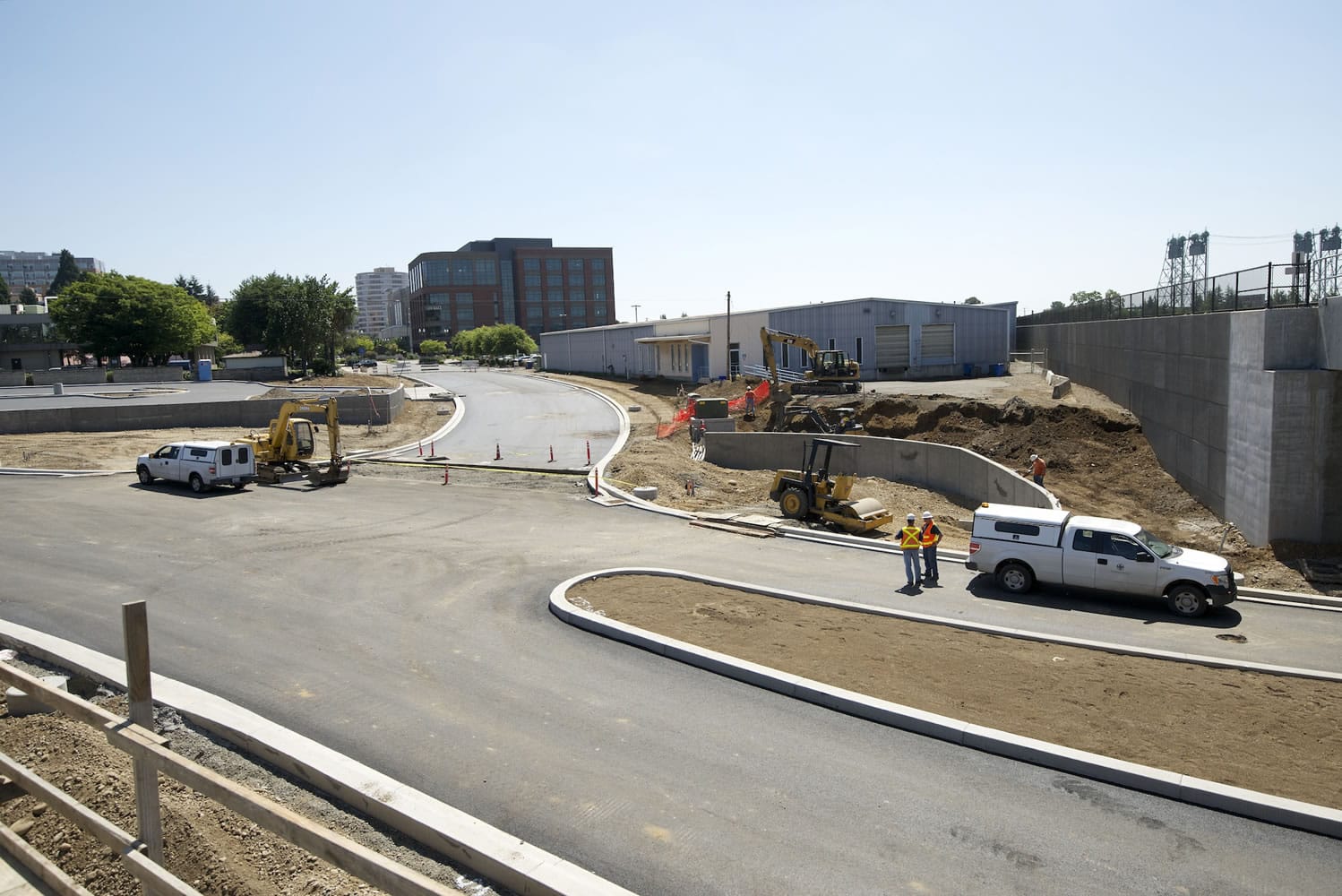Expenses for the city’s $45 million Columbia River waterfront access project are on target, the Vancouver City Council heard Monday.
“It’s a good place to be,” said Matt Ransom, the city’s project development and policy manager. The project includes two new railroad bridges at Esther and Grant streets, three new streets, the closure of railroad crossings at Jefferson and Eighth streets and related utility work.
The work fulfills the city’s pledge to create public access to the former Boise Cascade site, which, private investors believe, has the potential to be a defining cityscape.
In 2012, crews punched through the BNSF Railway berm south of City Hall on Esther Street, offering a view to the river that had been hidden for more than a century.
Ransom said the streets should be open in August and the Jefferson Street railroad crossing should be closed by November. At that point, a street will connect Jefferson to Eighth Street.
The Eighth Street crossing has closed, Ransom told the city council, adding that the city didn’t have to get approval from the Federal Railroad Administration to establish a quiet zone because closing the crossing ended the need for trains to sound their horns.
The $45 million, a mix of state and local money, includes property acquisition costs, Ransom said. For example, the city closed a deal in 2010 with The Columbian for $4.38 million for access to Grant Street and a building at 615 W. Sixth St. The section of Grant Street was vacated by the city in the 1950s and had been, until earlier this year, part of The Columbian’s parking lot. Grant Street will be connected between Sixth and Eighth streets, Ransom said.
Even after the streets are open to the public, Ransom said he anticipates the Vancouver Farmers Market will continue to use a section of Sixth Street just west of the roundabout in front of City Hall. So, during the market season, the street would be closed on weekends.
Still, people could access the waterfront on Grant Street, he said.
Bright spot
The news that expenses are on target was a bright spot for the project, which fell behind schedule due to difficulties with right-of-way access and tight railroad construction windows,
A 2009 development agreement with Columbia Waterfront LLC — a group composed of Gramor Development of Tualatin, Ore., and its local investors — called for the access work to be substantially completed by the end of 2011, with full completion by mid-2012.
Barry Cain, president of Gramor Development, told the council that timing has worked out because the economy has picked up.
On its website, Gramor describes “The Waterfront Vancouver” as the city’s “largest commercial, urban development to date, valued at more than $1.5 billion.”
“The development is set to bring a vibrant mix of retail, living and green spaces to the city, as an extension of the downtown core’s reconnection to the waterfront,” the website reads. “By reclaiming nearly 32 acres and 22 city blocks of available property, the planned environmentally conscious design will reflect the spirit of the Pacific Northwest with urban-friendly space and ample transportation links to the city, region and world beyond.”
While no contracts have been signed, Cain told councilors he anticipates construction starting in summer 2015. Recalling past projects, he said once the access roads are completed and work starts on the park, the site will be easier to market because potential
occupants can envision what it will look like.
Cain referenced a smaller mixed-use project in Lake Oswego. Once the city built a park, “it just made all the difference,” he said.
Ambitious plans for the former industrial site include expansion of the city’s Waterfront Renaissance Trail, a 10-acre park and a multiphase development including restaurants, 3,300 residential units, more than 1 million square feet of office space, 175,000 square feet of retail space and at least one hotel, Ransom said.
Ransom said it should take 12 to 18 months to secure permits for the waterfront park.
Councilor Bill Turlay questioned the wisdom of spending money on a waterfront park when the city has been cutting the parks budget. Ransom said the park will be deeded to the city, and the investment in such an amenity will help Columbia Waterfront LLC market the property.
Cain said he knows the city’s park budget has been cut, but he’s confident a supplemental maintenance and security budget will be developed between the city and tenants to keep the park “at a level we want to see it.”
Stephanie Rice: 360-735-4508 or stephanie.rice@columbian.com.



